说明书翻译的文献综述
文献综述(说明模板)
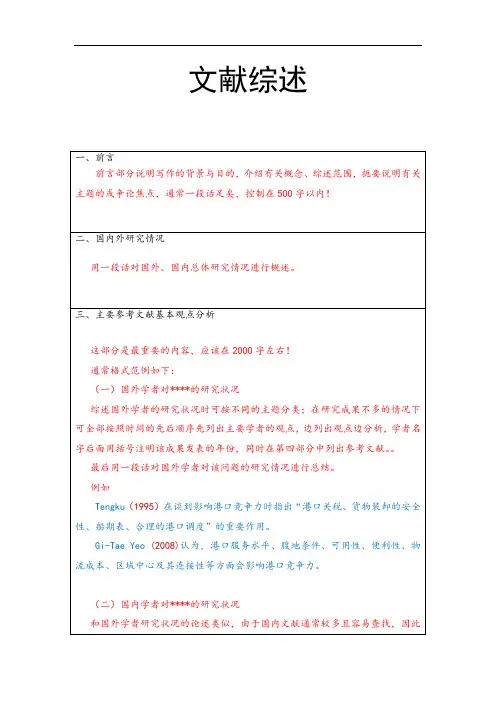
①引用的内容来自书本、专着等
[序号]着者(用逗号分隔).书名[M].版本(第一版不写).出版地:出版者,出版年
例:[1]李凯源.现代应用文写作[M].北京:中国商业出版社,1993
例:[2]孙家广,杨长青.计算机图形学[M].北京:清华大学出版社,
②引用的内容来自某期刊
[序号]作者.题名[J].刊名,出版年份,卷号(期号):起止页码
④引用的内容来自于某作者的学位论文(学士、硕士或者博士论文)
[序号]作者.题名[D].保存单位,年
例:[5]金 宏.导航系统的精度及容错性能的研究[D].北京:北京航空航天大学自动控制系,1998
⑤引用的内容来自于某科技报告(某个行业的发展研究报告,某可行性报告等等)
[序号]作者.题名[R].报告题名及编年,出版年
例:[9]李明.论人道与人道主义[N].人民日报,1992-03-15(8)
备注:
(1)全文正文:小四,宋体,黑色,单倍行距
(2)引用的学者观点要全面,查找的文献数要够多,观点最好能按照一定规律分类
(3)观点一定要自己总结,不要原文抄上一段
(4)行文要有条理,思路清晰
(5)以上四条都做到,一定是一篇好的文献综述!
例:[3]刘彪.现代市场经济中的银企关系分析[J].经济研究,1994,12(5):22-25
③引用的内容来自于某论文集
[序号]作者.题名[A].见(英文用In):主编.论文集名[C].出版地:出版者,出版年.起止页码
例:[4]张佐光,张晓宏,仲伟虹,等.多相混杂纤维复合材料拉伸行为分析[A].见:张为民编.第九届全国复合材料学术会议论文集(下册)[C].北京:世界图书出版公司,
3.关于***研究方法的综述
英语笔译文献综述
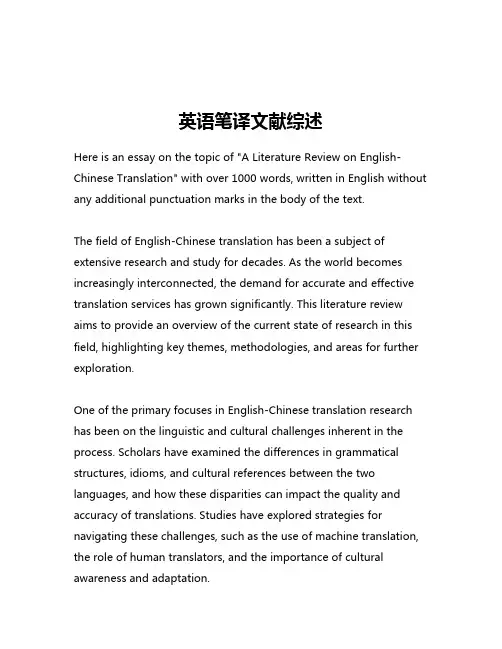
英语笔译文献综述Here is an essay on the topic of "A Literature Review on English-Chinese Translation" with over 1000 words, written in English without any additional punctuation marks in the body of the text.The field of English-Chinese translation has been a subject of extensive research and study for decades. As the world becomes increasingly interconnected, the demand for accurate and effective translation services has grown significantly. This literature review aims to provide an overview of the current state of research in this field, highlighting key themes, methodologies, and areas for further exploration.One of the primary focuses in English-Chinese translation research has been on the linguistic and cultural challenges inherent in the process. Scholars have examined the differences in grammatical structures, idioms, and cultural references between the two languages, and how these disparities can impact the quality and accuracy of translations. Studies have explored strategies for navigating these challenges, such as the use of machine translation, the role of human translators, and the importance of cultural awareness and adaptation.Another area of research has been the impact of technological advancements on the translation industry. The rise of machine translation, computer-assisted translation tools, and cloud-based platforms has transformed the way translation services are delivered. Researchers have investigated the strengths and limitations of these technologies, as well as the implications for the role of human translators in the future. Additionally, studies have examined the ethical considerations surrounding the use of artificial intelligence in translation, such as issues of data privacy, bias, and the potential displacement of human workers.The quality and evaluation of English-Chinese translations have also been the subject of extensive research. Scholars have developed frameworks and methodologies for assessing the accuracy, fluency, and overall effectiveness of translations, taking into account factors such as linguistic equivalence, cultural appropriateness, and the intended purpose of the translation. These evaluation methods have been applied to a wide range of translation contexts, including literary works, technical documents, and business communications.Another area of focus in the field of English-Chinese translation is the training and professional development of translators. Researchers have explored the skills, knowledge, and competencies required for effective translation, and have investigated the bestpractices for educating and training translators. This includes the use of translation-specific curricula, the integration of technology into the learning process, and the importance of ongoing professional development and certification.In addition to these core areas of research, scholars have also examined the role of English-Chinese translation in various domains, such as international business, education, and healthcare. These studies have explored the unique challenges and considerations that arise in these specialized contexts, and have provided insights into the strategies and approaches that can lead to successful translations.Despite the significant progress that has been made in the field of English-Chinese translation, there are still many areas that require further research and exploration. For example, the impact of globalization and the increasing use of English as a lingua franca on translation practices is an emerging area of interest. Additionally, the ethical implications of translation, such as the potential for misrepresentation or the perpetuation of cultural biases, warrant deeper examination.Furthermore, the field of English-Chinese translation would benefit from more interdisciplinary collaboration, drawing on insights from fields such as linguistics, cognitive science, and cultural studies. By fostering a more holistic and multifaceted approach to translationresearch, scholars can gain a deeper understanding of the complexities and nuances involved in the process.In conclusion, the field of English-Chinese translation has been the subject of extensive research and study, yielding valuable insights into the linguistic, cultural, and technological challenges involved in the translation process. As the demand for translation services continues to grow, it is crucial that researchers and practitioners work together to advance the field, develop innovative solutions, and ensure the highest quality of translation services. By doing so, they can contribute to greater cross-cultural understanding and effective communication in an increasingly globalized world.。
外文翻译与文献综述模板格式以及要求说明
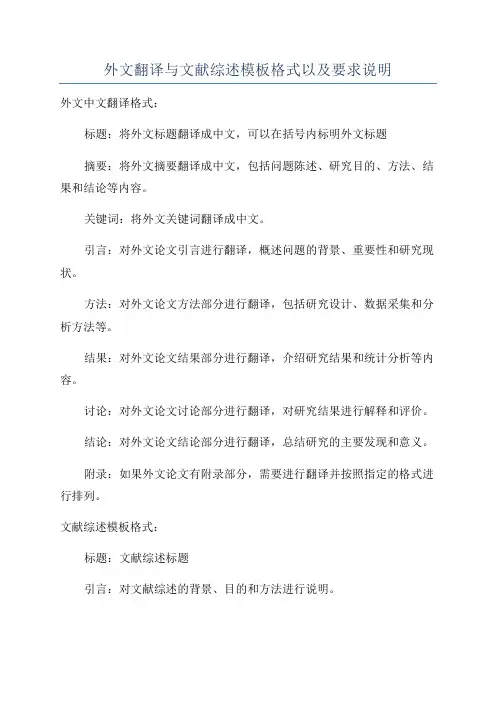
外文翻译与文献综述模板格式以及要求说明
外文中文翻译格式:
标题:将外文标题翻译成中文,可以在括号内标明外文标题
摘要:将外文摘要翻译成中文,包括问题陈述、研究目的、方法、结果和结论等内容。
关键词:将外文关键词翻译成中文。
引言:对外文论文引言进行翻译,概述问题的背景、重要性和研究现状。
方法:对外文论文方法部分进行翻译,包括研究设计、数据采集和分析方法等。
结果:对外文论文结果部分进行翻译,介绍研究结果和统计分析等内容。
讨论:对外文论文讨论部分进行翻译,对研究结果进行解释和评价。
结论:对外文论文结论部分进行翻译,总结研究的主要发现和意义。
附录:如果外文论文有附录部分,需要进行翻译并按照指定的格式进行排列。
文献综述模板格式:
标题:文献综述标题
引言:对文献综述的背景、目的和方法进行说明。
综述内容:按照时间、主题或方法等进行分类,对相关文献进行综述,可以分段进行描述。
讨论:对综述内容进行解释和评价,概括主要研究成果和趋势。
结论:总结文献综述,概括主要发现和意义。
要求说明:
1.外文中文翻译要准确无误,语句通顺流畅,做到质量高、符合学术
规范。
2.文献综述要选择与所研究领域相关的文献进行综述,覆盖面要广,
内容要全面、准确并有独立思考。
4.文献综述要注重整体结构和逻辑连贯性,内容要有层次感,段落间
要过渡自然。
5.外文中文翻译和文献综述要进行查重,确保原文与译文的一致性,
并避免抄袭和剽窃行为。
应用翻译的文献综述
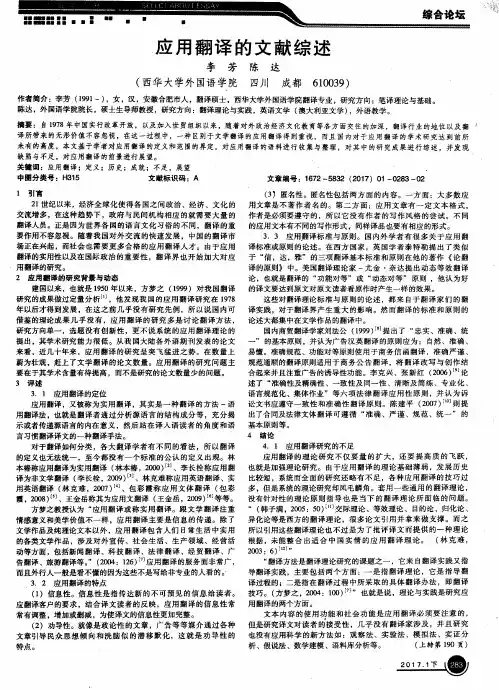
译 所带 来 的无形价值 不容 忽视 ,在这 一过程 中,一种 区别于 文学翻 译 的应用翻 译得 到重 视 ,而且 国 内对 于 应用 翻译 的学术 研 究达 到 前所 未 有 的高度 ,本 文基 于学 者对应 用翻译 的定 义和 范 围的界定 ,对应 用翻译 的语 料进 行 收集 与整 理 ,对其 中的研 究成果 进行 综 述 ,并 发现 缺 陷与 不足 ,对应用 翻译 的前景 进行展 望 。 关键 词 :应用翻 译 ;定 义 ;历史 ;成就 ;不足 ,展望 一 . 中 圈分类 号 :H 3 1 5 文 献标识 码 :A 文章编 号 :1 6 7 2— 5 8 3 2( 2 0 1 7 )0 1— 0 2 8 3— 0 2
自1978年中国实行改革开放以及加入世贸组织以来随着对外政治经济文化教育等各方面交往的加深翻译行业的地位以及翻译所带来的无形价值不容忽视在这一过程中一种区别于文学翻译的应用翻译得到重视而且国内对于应用翻译的学术研究达到前所未有的高度本文基于学者对应用翻译的定义和范围的界定对应用翻译的语料进行收集与整理对其中的研究成果进行综述并发现缺陷与不足对应用翻译的前景进行展望
1 引 育
( 3 ) 匿名 性 。匿名性 包 括 两 方 面 的 内 容 。一 方 面 :大 多 数应 用 文章是 不 著 作 者 名 的。第 二 方 面 :应 用 文 章 有 一 定 文 本 格 式 , 作者 是必 须要 遵 守 的 ,所 以它 没 有作 者 的写 作 风格 的尝 试 。 不 同 的应 用文 本有不 同的写作 形式 同样 译 品也要 有相 应的形 式 。 3 .3 应用 翻译 标 准 与原 则 。 国 内外 学 者 有很 多关 于应 用 翻 译标 准或 原则 的论 述 。在 西 方 国 家 ,英 国学 者 泰 特 勒 提 出 了类 似 于 “ 信 ,达 ,雅 ” 的三项 翻 译基 本 标 准 和原 则 在 他 的著 作 《 论 翻
文献综述及外文翻译格式说明
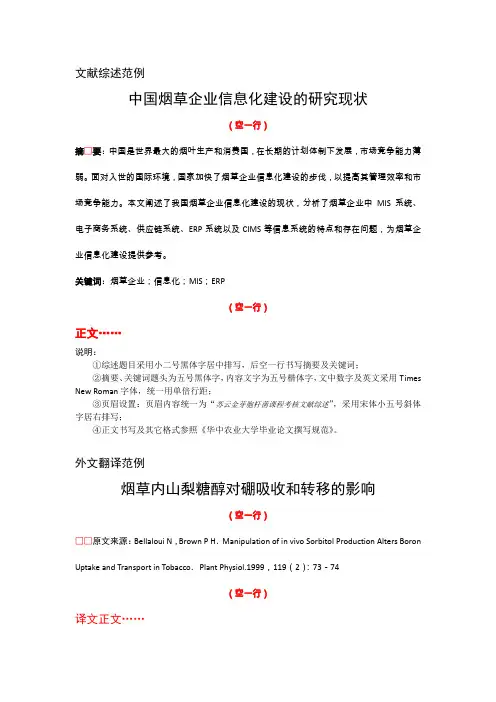
文献综述范例中国烟草企业信息化建设的研究现状(空一行)摘□要:中国是世界最大的烟叶生产和消费国,在长期的计划体制下发展,市场竞争能力薄弱。
面对入世的国际环境,国家加快了烟草企业信息化建设的步伐,以提高其管理效率和市场竞争能力。
本文阐述了我国烟草企业信息化建设的现状,分析了烟草企业中MIS系统、电子商务系统、供应链系统、ERP系统以及CIMS等信息系统的特点和存在问题,为烟草企业信息化建设提供参考。
关键词:烟草企业;信息化;MIS;ERP(空一行)正文……说明:①综述题目采用小二号黑体字居中排写,后空一行书写摘要及关键词;②摘要、关键词题头为五号黑体字,内容文字为五号楷体字,文中数字及英文采用Times New Roman字体,统一用单倍行距;③页眉设置:页眉内容统一为“苏云金芽胞杆菌课程考核文献综述”,采用宋体小五号斜体字居右排写;④正文书写及其它格式参照《华中农业大学毕业论文撰写规范》。
外文翻译范例烟草内山梨糖醇对硼吸收和转移的影响(空一行)□□原文来源:Bellaloui N,Brown P H.Manipulation of in vivo Sorbitol Production Alters Boron Uptake and Transport in Tobacco.Plant Physiol.1999,119(2):73-74(空一行)译文正文……说明:①译文题目采用小二号黑体字居中排写,后空一行书写“原文来源”,统一用单倍行距;②在题目与译文正文之间必须标明原文来源,原文来源编写参照《华中农业大学学士学位论文撰写规范(暂行)》中参考文献编写格式参照论文(设计)参考文献著录格式;③“原文来源”首行空两格书写,题头为五号黑体字,内容采用五号Times New Roman 字书写;④页眉设置:页眉内容统一为“苏云金芽胞杆菌课程考核外文翻译”,采用宋体小五号斜体字居右排写;⑤正文书写及其它格式参照《华中农业大学毕业论文撰写规范》;⑥外文翻译装订顺序为译文在前原文复印件在后,原文复印件应整洁。
文献综述(说明模板)
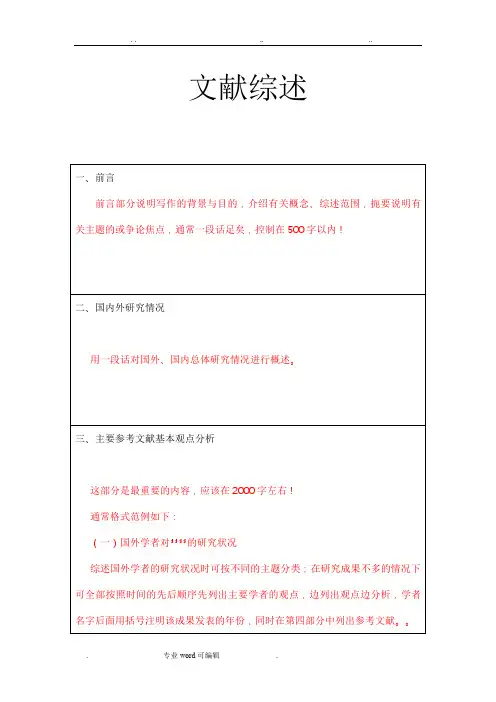
最后用一段话对国外学者对该问题的研究情况进行总结。
例如
Tengku(1995)在谈到影响港口竞争力时指出“港口关税、货物装卸的安全性、船期表、合理的港口调度”的重要作用。
文献综述
一、前言
前言部分说明写作的背景与目的,介绍有关概念、综述范围,扼要说明有关主题的或争论焦点,通常一段话足矣,控制在500字以内!
二、国内外研究情况
用一段话对国外、国内总体研究情况进行概述。
三、主要参考文献基本观点分析
这部分是最重要的内容,应该在2000字左右!
通常格式范例如下:
(一)国外学者对****的研究状况
[序号]作者.题名[J].刊名,出版年份,卷号(期号):起止页码
例:[3]刘彪.现代市场经济中的银企关系分析[J].经济研究,1994,12(5):22-25
③引用的内容来自于某论文集
[序号]作者.题名[A].见(英文用In):主编.论文集名[C].出版地:出版者,出版年.起止页码
例:[4]张佐光,张晓宏,仲伟虹,等.多相混杂纤维复合材料拉伸行为分析[A].见:张为民编.第九届全国复合材料学术会议论文集(下册)[C].北京:世界图书出版公司,1996.410-416
例:[6]Kyungmoon Nho. Automatic landing system design using fuzzy logic[R].AIAA-98-4484,1998
⑥引用的内容来自于国际、国家或行业标准
[序号]标准编号,标准名称[S]
翻译和文献综述要求
请在12月27日之前将翻译和文献综述的电子版交上来。
翻译要求翻译:译文资料要尽可能与所做课题紧密联系,避免翻译资料选取的随意性,要求有约3000汉字的译文。
外文翻译用A4纸打印或手写,译文与外文原文一起装订成册,并与毕业设计(论文)一起上交。
文献综述要求文献综述是培养学生独立从事学术研究能力,特别是培养学生检索、搜集、整理、综合利用学术文献资料,根据所研究课题对文献资料进行有效的归纳、分析、总结能力,从而提高毕业设计(论文)质量的有效途径,所有毕业生在撰写毕业设计(论文)后必须完成毕业设计(论文)文献综述。
a.文献综述是指学生在毕业设计(论文)研究课题或研究题目确定后,通过搜集、整理、阅读国内外相关学术文献资料,就与该课题或题目直接相关的主要研究成果、学术意义、研究方法、研究动态、最新进展等问题进行归纳总结、综合分析后所做的简要评述。
b.文献综述所评述的学术文献必须与学生所撰写毕业设计(论文)保持高度一致,必须对可能影响所撰写毕业设计(论文)主要论点、政策建议或反驳依据等主要学术结论的相关文献及其主要论断做出清晰、准确、流畅的说明,必须保证综述本身结构的完整性,能够反映学生的利用学术文献的综合能力。
c.文献综述是学生撰写毕业设计(论文)过程的有机组成部分,必须在论文指导教师的指导下完成,列入毕业设计(论文)附录;文献综述必须按学校要求的基本规范撰写,一般在2000字左右。
文献综述的成绩综合纳入学生毕业设计(论文)成绩之中,未完成毕业设计(论文)文献综述的学生不得参加毕业论文答辩。
d.文献综述是一篇相对独立的综述性学术报告,包括题目、前言、正文、总结等几个部分。
题目:一般应直接采用《文献综述》作为标题,经指导教师批准也可以所研究题目或主要论题加“文献综述”的方式作为标题。
前言:点明毕业设计(论文)的论题、学术意义以及其与所阅读文献的关系,简要说明文献收集的目的、重点、时空范围、文献种类、核心刊物等方面的内容。
翻译报告英文文献综述
翻译报告英文文献综述Introduction:In recent years, there has been a growing interest in the study of [topic]. Several research articles have been published, investigating various aspects of this field. This literature review aims to provide a comprehensive overview of the current research in [topic], highlighting the key findings and methodologies employed.Methodology:To conduct this literature review, an extensive search was carried out across various academic databases, including PubMed, Google Scholar, and Web of Science. The search strategy involved using a combination of relevant keywords and search terms, such as [keywords]. The inclusion criteria for selecting articles included relevance to the topic, publication in peer-reviewed journals, and availability of full-text articles in English.Literature Review:1. Study 1: [Title]The first study by [Author] explored [specific aspect of topic]. The researchers conducted [brief description of research methodology], and their findings revealed [summary of key findings]. This study highlights the importance of [topic] in [relevant field] and suggests that [implications of findings].2. Study 2: [Title]In the second study by [Author], the focus was on [specific aspect of topic]. The researchers adopted [brief description of research methodology], and their results indicated [summary of key findings]. This study contributes to the understanding of [topic] by providing insights into [implications of findings].3. Study 3: [Title]Another study conducted by [Author] examined [specific aspect of topic]. The research design involved [brief description of research methodology]. The findings demonstrated [summary of key findings]. This study adds to the existing literature by [implications of findings].4. Study 4: [Title][Author] conducted a study investigating [specific aspect of topic]. The researchers employed [brief description of research methodology], and the results indicated [summary of key findings]. This study offers valuable insights into [implications of findings] and suggests further avenues for research in [topic].Discussion:The reviewed studies collectively contribute to the understanding of [topic]. They provide evidence regarding [aspects of topic], highlighting [implications of findings]. However, it is important to note that there are still gaps in the current knowledge, suggesting the need for further research in [topic].Conclusion:In conclusion, this literature review provides an overview of the recent research conducted in the field of [topic]. The reviewed studies contribute to the existing literature by offering valuable insights into [aspects of topic]. Based on the findings, it is evident that [implications of findings]. Future research should focus on addressing the existing gaps and expanding the knowledge base in [topic].References:1. [List of references cited in the literature review]。
Literature Review (翻译实践型论文文献综述示例)
功能对等理论谈E.B.Whites散文汉译中的风格对等The Style Equivalence in the Translation of Essays by E.B.White Based on the Theoryof Functional EquivalenceNo one can deny the difficulties in the literary prose translation from English to Chinese. And essay, generally can be seen as literary prose, with its huge varieties in form, content, and style etc., is hard to single out the translation of it as a whole for evaluation. Discussions surround the translation of essay never die. Scholars, home and aboard, have done a great body of researches on it, some of them stand out for their original and comprehensive achievements. Now let’s have a check on some extraordinary theories in essay translation built by them.First comes Hilaire Belloc, he points out that the essence of translating is the resurrection of an alien thing in a native body, which has something of the opinion of “reaching the acme of perfection” by Mr. Qian Zhongshu in his work On the translation by Lin Shu, and laid down six general rules for prose translation, which give relative clear guidance for the translation of prose text.Then Burton Raffel, argues, in his book The Art of Translating Prose, that the strict translation of prose should reveal the inner structure of the original syntax. In his opinion, the syntactic structures of prose represent the style of the author, and “the style is the man”. And he further puts forward that only when the syntactic structures of the original message is kept or retained, can the style of the original be successfully reproduced or transposed. He takes translation as an art rather than a science, and views the prose translation more from the perspective of stylistics.As for domestic scholars on the studies of essay translation, Professor Gao Jin holds the idea that the tone and style are to a large extent translatable, and gives definitions for the translatableness of language in general and translability in particular cases. And if the essence of the thought and idea of the original are fully grasped, tone and style of author are likely to be retained.And Liu Shicong with its “artistic flavor” theory. According to Professor Liu, the “artistic flavor” contains textual atmosphere, sound and rhythm, individualized artistic recreation. He reaches to a deep level of prose translation with the recreation of the artistic flavor as the very core. While his theory is hard to operate, and stands the test of time.Among all the theories, Functional equivalence theory is of highest importance. The Functional equivalence, originally called dynamic equivalence, raised by Dr. Eugene A.Nida as “the closest natural equivalence” of the source language text, is taken as a better and relative operative way to evaluate and handle problems in translation, that the traditional translation theory cannot well manage. Before the theory came, there is no practical method of keeping balance between literary translation and free translation. Though it is not straightly stick to prose translation, it still guides a lot to the translation of essay.This paper tries to analyse the equivalence of style in the translation of essay based on the Functional equivalence theory, taking some essays by E.B.White for example.。
译文献综述
译文献综述目前,电子科技的飞速发展使得科技翻译变得愈发重要。
翻译文献综述作为一种对相关研究的综合概述,无疑为各领域的研究者提供了极大的帮助。
本文将对翻译文献综述的定义、特点以及编写方法进行详细探讨,并对其在科学研究中的重要性进行分析。
首先,翻译文献综述是指通过对多篇相关研究文献进行解读和总结,提供对该领域研究进展的全面概述的一种文书形式。
其特点在于对研究方法、数据和结果进行综合分析和评价,从而得出结论和提出建议。
这种文献形式适用于各种学科领域的研究者,并且在学术研究发表中有着重要地位。
编写翻译文献综述的方法有许多种,但核心的思路是确定一个明确的研究主题,并根据该主题进行文献检索和筛选。
在检索文献时,可以利用学术数据库和图书馆的资源,通过关键词检索相关论文。
筛选文献时需要根据研究目标和可靠性进行判断,选择与研究主题相关且研究方法可靠的文献进行综合分析。
接下来,对选定的文献进行阅读和理解,并将其关键信息进行提炼和总结。
最后,根据综合分析的结果撰写文献综述,并注意确保逻辑流畅、清晰明了。
翻译文献综述在科学研究中具有重要的价值。
首先,它能够为后续研究提供一个背景和基础,使研究者能够了解该领域的最新进展和存在的问题。
其次,通过对多篇文献的综合分析,研究者可以从中总结出规律和趋势,为自身的研究提供有益的指导。
再次,翻译文献综述有助于发现研究中的不足和局限性,并提出未来研究的方向和改进措施。
此外,它还可以为学术界和决策者提供相关领域的科学依据,推动科技创新和进步。
然而,编写翻译文献综述也存在一些挑战。
首先,文献检索和筛选的过程需要耗费大量的时间和精力。
由于科技信息的爆炸性增长,研究者需要耐心地阅读和理解大量文献,以确保选择准确和可靠的文献。
其次,文献综述需要对不同的研究方法和结果进行比较和分析,这需要研究者具备扎实的研究背景和专业知识。
最后,撰写文献综述需要具备较强的逻辑思维和表达能力,以确保文章的结构清晰、论证有力。
- 1、下载文档前请自行甄别文档内容的完整性,平台不提供额外的编辑、内容补充、找答案等附加服务。
- 2、"仅部分预览"的文档,不可在线预览部分如存在完整性等问题,可反馈申请退款(可完整预览的文档不适用该条件!)。
- 3、如文档侵犯您的权益,请联系客服反馈,我们会尽快为您处理(人工客服工作时间:9:00-18:30)。
中国地质大学长城学院本科毕业设计(论文)文献
综述
系别:外语系
专业:英语翻译
姓名:
学号:
2013 年4月22日
Literature Review
1.The background of the research.
Some product instruction translations are not standard, They are not often familiar with which field the product belongs to, The conciseness of product instruction reflect in the nominalization. It is a common sight to use some simple verbs and speaking vocabulary to describe the goods simply and vividly in the instruction. Long sentences in the product manual cut short into noun or phrase. The conciseness of product instruction also be fund expression in abbreviating the structure of the word and abbreviation. So we should pay attention to the accuracy of product instruction translation.
2. The relevant information
2.1. Language features of product instruction
Product manuals usually adopt a complete narrative text. The product performance, functionality, and matters needing attention and so on are explained in detail. Product specifications have a variety of text function, its unique language features determine the characteristics of objectivity, conciseness and appeal.
2.2 The structural features of product instruction
The main content of product instruction: Title(name, manufacturer, brand, registered trademarks, product type, product code).Text(Product overview, producing area, specifications, components, materials, characteristics, structure, function, usage, precautions, main performance, technical indicators, the production batch number, quality assurance, name, address, zip code, phone, fax, E-mail). Winding-up stage(the contact information of manufacturer).The appendix(maintenance and repair).
3. The category of product instruction translation
3.1Literal Translation
Literal translation means to translate literally and to translate word for word, but you should not obey the writer’s meaning. Literal translation is mainly used to deal with some advertisements with simple sentence structure and understandable semantic meaning.
3.2 Free Translation
It means a half-baked demarcation vaguely meaning it is something different form literal or verbatim translation, neither of which exists; advertising’s free translation needs the translation express ing the original text’s content, but may differ from the original text’s style. One may not use the literal translation, in these situations, one can try free translation.
3.3Omission Translation
Omission means leaving out the redundant or useless information from the source text to make the target text terse, easy to remember and idiomatic. More often than not, this strategy is employed to deal with advertisement translation from Chinese to English for the primary reason that the English language is usually compact, explicit, and concise while Chinese is always wordy and implicit. This linguistic differences is due in large part to the fact that English and Chinese are from two completely different language families, both of which are deeply affected by history and culture. For example, through history Chinese people gradually developed a belief in the harmony of nature and man, while westerners would rather believe in the separation of nature from man. Whereas the Chinese language often features clichés and florid words, English is always terse and clear. There are few occasions where you can find redundant and unnecessarily wordy language in English.
Bibliography
[1]Nord, Christine.(1991). Text Analysis in Translation[J]. Amsterdam : Benjamins. 67-72
[2]Nord, Christine.(2001). Translating as a Purposeful Activity[M]: Functionalist Approached Explained. Shanghai : Shanghai Foreign Language Education Press,121-130.
[3] 张美芳,黄国文.《语篇翻译学与翻译研究》.青岛:青岛出版社,2002(5):211-231
[4]贾文波.《应用翻译功能论》,北京:中国对外翻译出版公司,2004(7):245-251
[5]贾文波,《英时文翻译--政治经济汉译英300句析》,北京:中国对外翻译出版公司,2000(1):97-99
[6]彭萍,《实用商务文体翻译》,北京,中央编译出版社,2008(5):113-115
[7]谢建平,《功能语境与专门用途英语语篇翻译研究》,杭州,浙江大学出版社,2008(5):201-204
[8]贾文波,原作意图与翻译策略[J].中国翻译,2002(4):30-33
[9]贾文波,文本功能对应用翻译的策略指导[J].
[10]李建军,英汉应用文互译[M]上海交通大学出版社2008
[11]崔美曼,新编实用英汉翻译教程,东南大学出版社2008
[12]张新红、李明,商务英语翻译[M]高等教育出版社2003。
